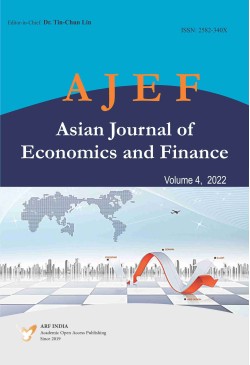
Asian Journal of Economics and Finance
Frequency :Quarterly
ISSN :2582-340X
Peer Reviewed Journal
Recognition had been made of no significant economic growth by any country without adequate development in her human capital. Looking at the “Asian tigers” such as Malaysia, India, Singapore, and South Korea made investment in education and health a top priority for decades, they have gradually leaved the class of developing economies. Singapore, a small country with virtually no natural resources, has become one of the most developed countries in Asia, primarily due to significant investments in developing her human capital. This shows that human capital is a key to the relevance of other forms of capital. To better understand human capital and economic growth, this study investigates the “dynamics of human capital and economic growth in West African countries” from 7 sampled West African countries covering a period of 17 years (20002016) based on annual panel series data availability. Five macroeconomic variables were selected based on theoretical and empirical evidence. The study conducted preestimation tests such as; summary descriptive statistics, Pearson’s matrix correlations and panel unit root test. The test results revealed that, the variables under study are properly screened for more advanced statistical regressions. the co integration result revealed that, majority of the seven “within” and “between” dimensions tests have confirmed the significant existence of co integration amongst the variables The central conclusion is that there is the existence of a longrun equilibrium relationship among the variables Therefore, the study recommends that, West African government`s expenditures on education and health should be increased so as to rise the literacy rate and life expectancy rate level and to RGDP of West African countries.
Keywords: Economic Growth, Human capital, Panel Cointegration
Most momentum researches are based on the seminal work advocated by Jegadeesh and Titman (2001), i.e., sorting and trading all the stocks in a market. In reality, investors rarely trade assets of the whole market. In the literature, no study has tested the effectiveness of momentum strategies on IPOs in the literature.This paper applies momentum strategies to the IPO stocks of Hong Kong. It is found that taking long positions of IPOs in Hong Kong by employing momentum strategies can generate a significant monthly return.
Keywords: Momentum Strategies; Time Series Momentum; IPOs.
India is one of the fastest growing economies of the world and high population dividend in terms of dependency ratio (percentage of working population in total population, 52.45). The economic reforms led to structural changes in Indian economy. In paper attempt has been made to find the contribution of labour in our exports, by using the newly developed World Bank Labour Content of Exports (LACEX) Database for 24 sectors,in case of India for 1995, 2001, 2007 and 2011. Paper hasbeen divided into five sections. Section I considers the review of literature; section II discusses export performance; section III concentrates on trends and growth in labor value added content (skilled and unskilled labour); section IV discusses impact of exports on growth and correlation of skilled, unskilled and total labour content with exports and section V deals with conclusions and policy implications. The study reveals that in case of total share of labour content in exports, the share of unskilled labour remained high but the share of skilled labourhad been increasing, while share of unskilled labour had been decreasing.
The paper seeks to explain the nature and prospects of trade and monetary integration in ASEAN during 1990-2017. Growth,structural breaks of Intra export and intra import shares of ASEAN including external trade were shown and influencing factors like GDP, FDI, REER,openness and inflation were regressed with them. Short run and long run causalities were observed among the said variables through co integration and vector error correction models.Monetary integration was explained through capital market development especially in share and bond markets and in currency convertibility. Optimum currency area criterion was tested through Beta and Sigma convergence hypothesis which proved that the adoption of single currency in ASEAN is now not feasible.
Keywords: trade integration,monetary integration, intra export share, intra export share, optimum currency area, cointegration, vector error correction, short run causality, long run causality.
JEL codes: F02,F15,F34,G15,N25
Studying the impact of exchange rate movements on aggregate output in New Zealand based on an extended ISMPAS model (Romer, 2000), this paper finds that real depreciation raised real GDP during 1990.Q1 2003. Q4 whereas real appreciation increased real GDP during 2004.Q1 2017. Q2. In addition, a lower debtto GDP ratio, a lower lagged U.S. real federal funds rate, a higher stock price, a higher real oil price or a lower expected inflation rate would help increase real GDP. Hence, real depreciation or appreciation may increase or reduce real GDP depending upon the phase of economic growth.
Keywords: currency depreciation or appreciation; government debt; world interest rates; oil prices; ISMPAS model.
JEL codes: F41, E62